-
| |
Order
Hymenoptera
- This page contains pictures and information about Long-tongued Bees in Family
Anthophoridae that we found in
the Brisbane area, Queensland, Australia.
-
 -
- This family contains some largest bees in Australia. They make nest in dead
tree branches or underground. They are solitary bees but some species may nest close together in large numbers. Some
species are parasites of other bees' nests. They lay their own eggs in the brood cells of the host bees. They
carry pollen on hind legs.
-
- Some members in this family, like the Carpenter Bees and the
Blue-banded Bees, are known as buzz pollinators. They use special technique to get the
pollen from flowers known as buzz pollination. They hold the flowers and vibrate with loud buzz sound. The
vibration excited the flower which drop the pollen onto the bees body. The other
insects do not have this technique cannot get the pollen.
-
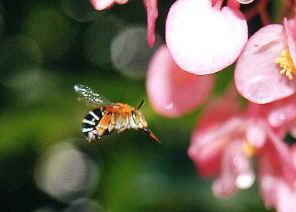 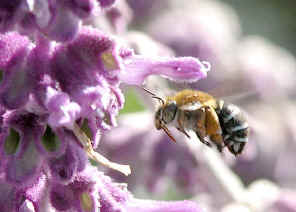  -
- The bees have long tongues which allow them to reach the nectar in tubular
flowers. Of course they feed on shallow flowers as well. None of these bees pose a serious threat to us, although the females do possess stings.
-
- The
Apidae and Anthophoridae are close relatives and
sometimes they are put in one family under Apidae. Following are those
Anthophorid bees that we found.
-
Subfamily Anthophorinae, Anthophorini - Large Banded
Bees
- Bees in this subfamily are large, robust, hairy and often banded. They
often nest in aggregations in ground or in bank of soil. Each female makes
her own nest. The forewings have three sub-marginal cells.
-
- Teddy Bear Bee

 - Amegilla bombiformis, body length 18mm
- The bee is golden brown in colour with dark brown bands on abdomen. We saw
this bee a few times, however, they fly fast and only stop on a flower
buzzing for one to two seconds. It is hard to take their pictures. Please visit this page for more information.
-
-
- Blue-banded Bee
  - Amegilla cingulata, body length 15mm,
female Males
- The thorax and head of Blue-banded Bees are covered with golden hairs and
abdomen is banded with pale blue bands on black. This is a solitary bee but
females may build nest together in same location with other
Blue-banded Bees. Their nests built underground. Male do not build
nest. They will cluster for the night hanging from stems or leaves by their
jaws. More information and pictures please click here.
-
Subfamily Anthophorinae, Melectini - Large Parasitic
Bees
- Bees in this group are cleptoparasitic, female does not make its own nest
nor feed their young but lays egg in the
nest of other species. They are not hairy for they do not collect
pollens.
-
- Neon Cuckoo Bee
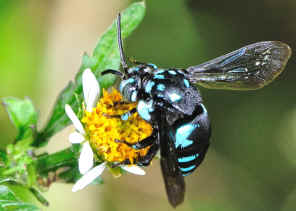 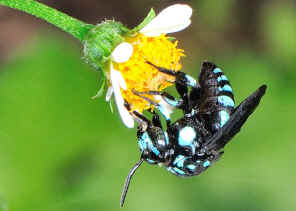 - Thyreus nitidulus, body length 15mm
- Above photos shows three Blue-banded Bees and one Cuckoo Bee. The
Neon Cuckoo Bee female does not make its own nest. It lays egg in the nest
of Blue-banded bee. Female places an egg in a partially completed brood
cell. After the blue-banded bee seals the brood cell, the cuckoo bee egg
hatches into larvae and feeds on the provisions stored by blue-banded bee.
Please check this page for more
information.
-
Subfamily Xylocopinae, Allodapini - Large Black
Bees
- Bees in this group often shiny black in colour. The forewing vine has r and 1m closed.
They nest in dead stems or in existing wood burrows. Females feed larvae
progressively. Some species show primitive social organisation behaviour.
-
- Large Black Bee
  - Braunsapis sp, body length 10mm
- We found this bee on Sep 2010 in Karawatha Forest. Please check this
page for more information.
Subfamily Xylocopinae, Xylocopini - Carpenter
Bees
- Bees in this group are large to very large in size. They are robust, hairy,
metallic black and green in colours. They make burrows in dead branches of
trees or dead flower stalks of Grass Tree Xanthorrhoea. The forewings
have two or three sub-marginal cells.
-
- Great Carpenter Bee
  - Xylocopa (Koptortosoma) aruana, body length 25mm
- Great Carpenter Bees are very large and hairy bees, with black abdomen and yellow thorax.
In fact they are the largest bee in Australia. Theirs wings are dark brown in colour. They are solitary, i.e., living on its
own. They feed on pollen. Females make
tunnel and lay eggs in decaying wood, including dry flower sticks of grass-trees Xanthorrhoea.
Please check this page for more information.
-
-
- Metallic Carpenter Bee, Peacock Carpenter Bee

 - Xylocopa (Lestis) bombylans, body length
20mm
- This is a large and hairy bee, with metallic black abdomen and thorax.
Wings are tinted dark brown in colour. They are solitary bees, nest in the
flower stem of grass trees Xanthorrhoea sp.. Please check this page
for more pictures and information.
-
-
- Green Carpenter Bee
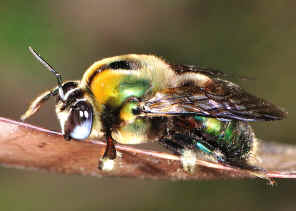 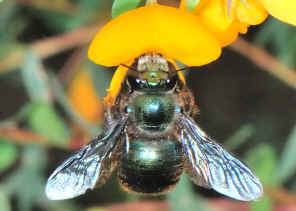 - Xylocopa (Lestis) aeratus, body length
20mm
- This is a large and hairy bee, with metallic green abdomen and thorax.
There are the golden hairs on thorax and abdomen.
Wings are tinted dark brown in colour. Female's
hairs are darker in colour. Please check this page
for more information.
-
- Reference:
- 1. Native
Bees of the Sydney region, a field guide - Anne Dollin, Michael Batley,
Martyn Robinson & Brian Faulkner, Australian Native Bee Research Centre.
- 2. Northern
Territory Insects, A Comprehensive Guide CD - Graham Brown, 2009.
[ Up ] [ COLLETIDAE ] [ HALICTIDAE ] [ MEGACHILIDAE ] [ ANTHOPHORIDAE ] [ APIDAE ] [ Unknown Bees ]
| |
|


















